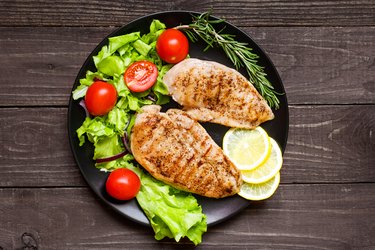
Protein comes from both plant and animal foods, but not all protein foods are created equal. If you need more of this nutrient without excess fat and calories, consider the protein in fish vs. chicken. Both are excellent sources, but there may be times when one is a better choice than the other.
Tip
The amount of protein in fish vs. chicken is often similar, but there are some differences in their nutritional value, so you might get the most benefit by mixing them up.
Video of the Day
Protein in Fish vs. Chicken
If you to want to get a jump on weight loss, filling up on high-protein foods can be a good strategy at least in the short-term, according to Harvard T.H. Chan School of Public Health. Chicken and fish are two convenient and easy-to-prepare protein sources that won't bust your calorie budget.
Video of the Day
The nutritional content of chicken can vary depending on the cut and whether or not you eat the skin. According to the USDA, a 100-gram serving of skinless chicken breast provides 165 calories and 31 grams of protein. That same size serving of chicken thigh with the skin has 225 calories and 23 grams of protein.
When deciding between fish and chicken for weight loss, you'll find a similar range between different types of fish. The USDA's data for a 100-gram serving of fish includes:
- Salmon: 188 calories and 25 grams of protein
- Canned tuna (in water): 86 calories and 19 grams of protein
- Sardines: 208 calories and 25 grams of protein
- Shrimp: 60 calories and 14 grams of protein
The bottom line is that if you're comparing fish to chicken for weight loss, either can be a good choice because they're both low in calories and high in protein.
Fish Offers More Variety
When you're trying to slim down, it's tempting to stick to a very strict diet to meet your calorie goals. Sometimes, that means eating lots of chicken day after day.
However, if you allow yourself to have more variety in your meals, you might find that you're losing weight without feeling deprived. Rather than choosing between fish vs. chicken for weight loss, mix them up a few times each week and try throwing a few meatless meals in the mix too.
One important benefit of adding more fish to your diet is that it may reduce your risk of heart disease. The Mayo Clinic and other health organizations recommend eating fish at least twice each week for a healthy heart. Fatty fish like salmon or sardines might have a bit less protein than chicken breast, but they both deliver high doses of omega-3 fats.
Compared to chicken, fish also provides some flavor variety for your meals. Grilled salmon, baked shrimp and tuna salad can all be part of weight loss-friendly meals that are also high in protein. Additionally, choosing a fish that's higher in omega-3 fats, like salmon vs. chicken for dinner, might keep you full and satisfied for longer.
Read more: The 9 Safest Seafood Options
How Much Protein to Eat
Protein requirements vary a bit from person to person because they're based on your body weight and activity level. Some research suggests that high-protein diets are more effective for weight loss than those lower in protein, but not all experts agree. There are other benefits to eating more protein, though.
A review published in the October 2017 issue of the journal Diabesity found that those who eat about 1.6 grams of protein per kilogram of body weight tend to maintain more lean body mass as they lose weight, and they typically feel more full and satisfied between meals.
Read more: How Protein Can Help You Lose Weight
It's easy to see that if you're comparing salmon vs. chicken as a protein source, they're both winners. As long as you prepare them in a healthy way and watch your portions, you'll find it easier to lose weight and preserve lean mass. When combined with exercise, their benefits are even greater.
- Harvard T.H. Chan School of Public Health: “Food and Diet”
- Mayo Clinic: "Omega-3 in Fish: How Eating Fish Helps Your Heart"
- Diabesity: “Modulating Weight Loss and Regain Through Exercise and Dietary Protein”
- USDA FoodData Central: “Chicken Thigh"
- USDA FoodData Central: "Chicken Breast"
- USDA FoodData Central: “Salmon, Cooked"
- USDA FoodData Central: “Tuna, Canned"
- USDA FoodData Central: “Sardines, Cooked”
- USDA FoodData Central: “Shrimp, Cooked”
- USDA National Nutrient Database: "Chicken, Roasting, Light Meat, Meat Only, Roasted"